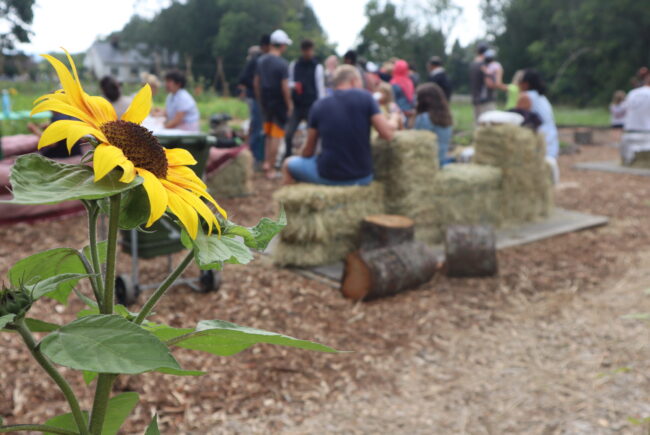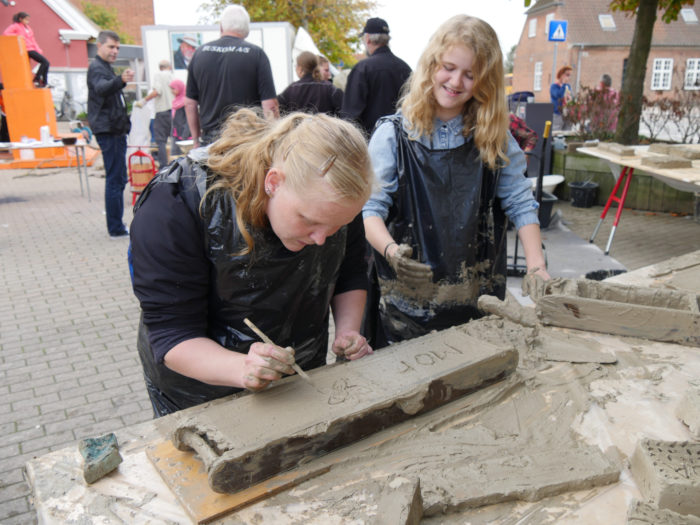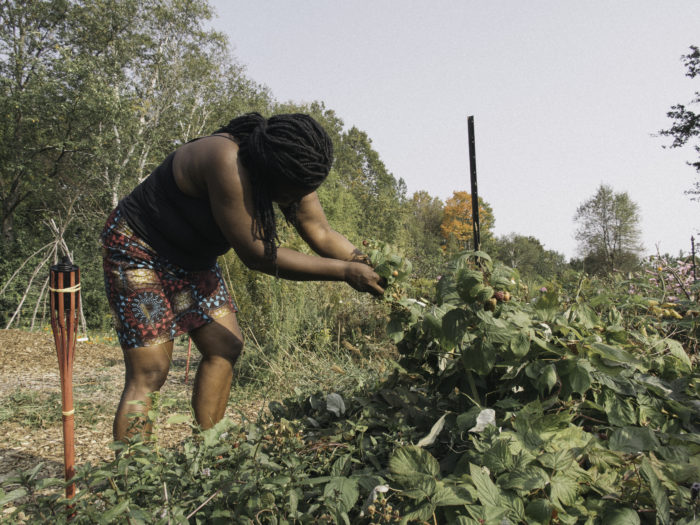

The historical Linderund farm in Oslo has recently been opened to the local community with one part of the farm turned into an open access community garden and event space. Photo credit: Nabolagshager
The historical Linderund farm in Oslo has recently been opened to the local community with one part of the farm turned into an open access community garden and event space. Photo credit: Nabolagshager
Urban gardening has exploded in popularity during the past year. Particularly for people from immigrant backgrounds, community gardens can offer an important space for participation.
The pandemic has pushed people all over the world outdoors, a trend particularly visible in cities: more and more people have explored urban forests, met friends on park benches or finally taken up urban gardening.
At the same time, the past year has highlighted how unequal the access to outdoors spaces can be. On the most basic level, this could mean the often-unequal distribution of green spaces between wealthy and poor neighbourhoods, but it is also linked to more complicated questions of social inclusion and exclusion, such as who the spaces are designed for, who feels like they can use them and who gets a say in developing them?
This is something that Anders Hagedorn and Martin Rosenkreutz Madsen have observed close up in Copenhagen, Denmark, where they are a part of Supertanker, a group developing opportunities for social, cultural and urban participation. One of their biggest projects has taken place in Charlottekvarteret, a social housing neighbourhood with the majority of its residents from immigrant backgrounds.
For years, Charlottekvarteret has had a “bad reputation” and the people living there have suffered stigmatisation. Supertanker’s work here has focused on facilitating projects to support community development and a collective identity. Creating shared outdoors spaces in collaboration with the residents is a big part of it.

The community garden in Charlottekvarteret provides residents with their own space, as well as an opportunity to work on the land and produce something. Photo credit: Farokh Berenjgani
In early 2020, just before the pandemic hit, the group started a community garden project, which has already become hugely popular.
“Most people here live in small flats and cannot afford a summer house outside the city. The community garden provides them with a little bit of their own space, as well as an opportunity to work on the land and produce something,” Anders Hagedorn explains.
This is particularly significant in a neighbourhood which, just like many social housing areas, is heavily regulated – people living here have traditionally not have much say in shaping their surroundings.
“This creates a strong contrast with history, as many residents have moved here from areas with a high level of autonomy, such as rural parts of Turkey. So, we want to develop ways for them to get involved in creating the spaces they are using.”
Martin Rosenkreutz believes that the need for accessible and participatory outdoor spaces in cities will keep increasing, as many people have now discovered the joys of outdoor activities.

In Charlottekvarteret Supertanker has designed a process for participative action, involving residents in the creation and shaping the space around them. Photo credit: Farokh Berenjgani
At the same time, global urbanisation means that, in the future, more and more people will live in cities. The big question is, Rosenkreutz continues, how cities can provide access to different forms of outdoor learning.
“Learning in an experiential and autonomous way, such as learning about gardening with your own family, should not be the luxury it has become. Our utopia is to turn areas such as Charlottekvarteret into learning laboratories.”
Barriers to participation can be invisible
Kim Weger works for the Norwegian think-and-do tank Nabolagshager on its Edible Cities Network project in Oslo. She has also spent a lot of time thinking about the connection between urban outdoor spaces and social inclusion.
The physical site for Weger’s project activities is the historical Linderund farm, which has recently been opened to the local community with one part of the farm turned into an open access community garden and event space.
Weger’s main task is to engage people who might not otherwise engage in using and further developing the space.
“We have seen an explosion in urban gardening, which is great. But typically, people who show up to these events are white, Norwegian women of a certain age. Almost 50 percent of the residents in this area are from immigrant backgrounds, and we want them involved as well.”
During the project, which started in the spring 2020, Weger has explored the often-invisible barriers that might stop people from participating. For example, when asked their reasons for not using the farm gardens, many people from immigrant families explained they thought the space was not for them, as there was a gate on the entrance.
“In Norway people are used to the idea that public space is there for them to use, but this is not the case in some other countries. We need to actively invite people to use the space and its opportunities.”

As part of the Edible Cities project at the Linderund Farm, 25 local young people were hired to work on the farm for the summer. Photo credit: Nabolagshager
One way to reach out to more people has been working closely together with the District Mothers—an organisation of immigrant women helping local families in their own languages.
The project group also applied for funding to work with local schools and, with sponsorship from a local company, were able to hire 25 young people to work on the farm for the summer.
“It was great to see how they really started to take ownership of developing this place, and how important it was for them to have a safe place to spend time with their peers and meet new people with similar interests.”
From being included to including others
Someone with a slightly different perspective on the issue is Akane Bessho, who is completing her PhD at the Department of Urban Engineering at the University of Tokyo. Her research entitled “theorizing social inclusion through urban agriculture: through the lens of immigrants and people with disabilities” explores the topic Bessho has been interested in for most of her life.
“I moved to the US with my family when I was 13. Being a newcomer there, I became fascinated by how people try to belong to a place. What is the actual process of making a place your own?” she explains.
Urban agriculture is a particularly interesting subject, Bessho continues, since it has so many benefits for people: one can connect with nature, have access to fresh produce and boost both physical and mental wellbeing.

Black Creek Community farm in Toronto, Canada, has the local immigrant communities heavily involved in managing the farm space, proposing new projects and inviting more people to join. Photo credit: Black Creek Community Farm
“For immigrants in particular, community gardens are great, as you can start by just having your own space and some peace, but then slowly open up to other people and learn about the local community and the wider society around you.”
As part of her research, Bessho observed the Black Creek Community farm in Toronto, Canada, where people from local immigrant communities are heavily involved in managing the farm space, proposing new projects and inviting more people to join.
During the life-story interviews Bessho conducted with some of the participants, she was particularly interested in the “role shift” the immigrants experienced during their involvement with the farm. The big change for many people was going from being the one to be included to the one including others in the local community, Bessho argues.
These findings, Bessho believes, highlight the need to see social inclusion as something dynamic, “a never-ending process of finding out what has not yet been fully addressed.”
“I think it’s important not to label people, as this easily creates a division into “us and them”. People want to be seen as part of the community, not as recipients of help or protection. Community gardens offer a great playground for this.”
Author







